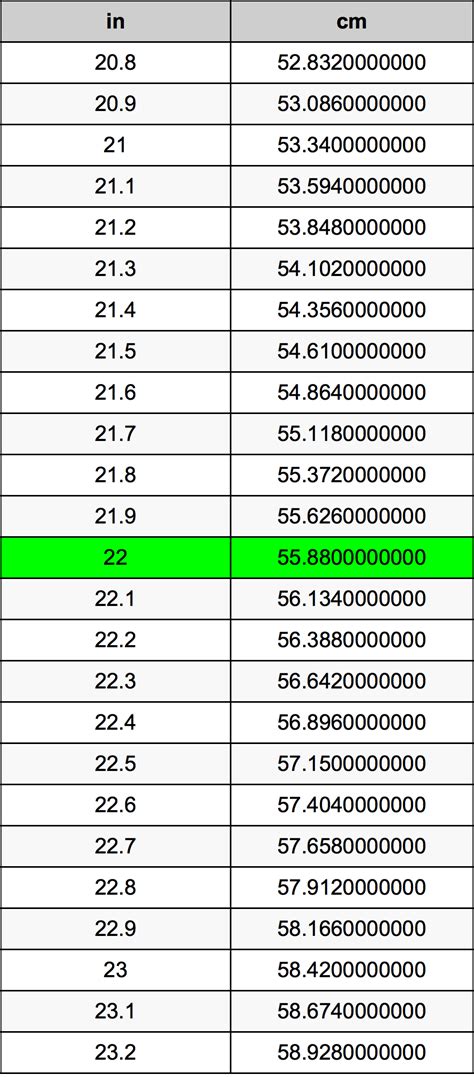How Big Is 22 Cm In Inches
Kalali
Mar 30, 2025 · 4 min read

Table of Contents
How Big Is 22 cm in Inches? A Comprehensive Guide to Metric-Imperial Conversions
The question, "How big is 22 cm in inches?" might seem simple, but it touches upon a fundamental aspect of measurement systems: the conversion between the metric system (centimeters) and the imperial system (inches). This seemingly straightforward conversion holds significance in various contexts, from everyday tasks to specialized fields. This comprehensive guide will delve into the conversion process, explore the size of 22 cm in inches, and discuss its practical applications.
Understanding the Conversion Factor
Before calculating the precise conversion of 22 centimeters to inches, let's establish the foundational conversion factor. The key lies in the relationship between centimeters and inches:
- 1 inch is approximately equal to 2.54 centimeters.
This is the cornerstone for all centimeter-to-inch conversions. While the conversion isn't perfectly whole, 2.54 is the universally accepted standard for accurate conversions.
Calculating 22 cm in Inches
Armed with the conversion factor, we can easily calculate the equivalent of 22 cm in inches. The calculation is straightforward:
22 cm / 2.54 cm/inch ≈ 8.66 inches
Therefore, 22 centimeters is approximately equal to 8.66 inches.
Visualizing 22 cm (8.66 Inches): Real-World Examples
Understanding the size of 22 cm (or 8.66 inches) requires visualizing it in a real-world context. Here are a few examples:
Everyday Objects:
- A standard ruler: Most rulers have both centimeters and inches marked. Finding the 22 cm mark on a ruler will give you a clear visual representation. You'll see it's a little shorter than 9 inches.
- A smartphone: The length of many smartphones falls within this range. Measuring your phone can offer a tangible understanding.
- A standard letter: The width of a standard-sized letter might be around 8.5 inches, quite close to our 22 cm.
- A dinner plate: Many dinner plates have diameters around 8-9 inches, providing another relatable size comparison.
More Specialized Examples:
- Wrist circumference: For those involved in jewelry making or watch sizing, understanding the length of 22 cm is crucial, as it’s a common wrist size measurement.
- Small electronic devices: The length or width of many small gadgets, like MP3 players or portable speakers often fall within this measurement range.
- Technical Drawings: Engineers and designers frequently encounter this dimension in blueprints and technical drawings, particularly in fields that involve smaller components.
Beyond the Simple Conversion: Factors Affecting Perception of Size
While the mathematical conversion is straightforward, the perceived size of 22 cm (8.66 inches) can depend on the context.
- Object shape: A 22 cm long, thin object will appear longer than a 22 cm wide, short object. The same measurement can result in very different visual impressions depending on the shape.
- Surrounding objects: The size of an object is often judged relative to the things around it. A 22 cm object will appear smaller next to larger objects and larger compared to smaller ones.
- Personal experience: An individual's perception of size can be influenced by their experiences and familiarity with certain objects of similar dimensions.
Importance of Accurate Conversions Across Disciplines
Accurate conversions are crucial in various fields, where precision is paramount:
- Engineering and Manufacturing: In these fields, even minor discrepancies can lead to significant issues. Consistent use of the correct conversion factor (2.54) is essential to prevent costly errors.
- Medical and Healthcare: Accurate measurements are vital in medical applications, from drug dosages to surgical procedures.
- Construction and Architecture: Construction projects rely heavily on accurate measurements for structural integrity and safety.
- International Trade: In global commerce, understanding and applying metric and imperial conversions is necessary for consistent communication and accurate documentation.
- Textiles and Fashion: This industry frequently uses both metric and imperial measurements for patterns, sizing, and garment specifications.
Avoiding Conversion Errors: Tips and Tricks
To avoid mistakes during centimeter-to-inch conversions:
- Always use the standard conversion factor (2.54 cm/inch).
- Double-check your calculations. Using a calculator can help reduce human error.
- Familiarize yourself with commonly used conversions. Knowing the approximate equivalents of key measurements will help in estimations.
- For critical applications, use a conversion tool or software. Professional conversion tools can minimize the risk of error in important tasks.
Conclusion: Mastering Metric-Imperial Conversions
The seemingly simple conversion of 22 cm to inches underscores the importance of understanding and correctly applying conversion factors. While the numerical answer is relatively straightforward (approximately 8.66 inches), the implications extend far beyond a simple mathematical calculation. Precise conversions are crucial for accuracy and consistency across various disciplines, emphasizing the need for careful attention to detail and the use of appropriate conversion methods. By mastering metric-imperial conversions, you equip yourself with a vital skill applicable in countless situations, from everyday tasks to specialized professional applications. Understanding the size and significance of 22 cm (8.66 inches) serves as a valuable stepping stone in this process.
Latest Posts
Latest Posts
-
Write 94 As A Fraction In Simplest Form
Apr 01, 2025
-
How Long Is 60 Inches In Cm
Apr 01, 2025
-
How Many Seconds Are In 6 Minutes
Apr 01, 2025
-
True Or False Breaking Up Concrete Is A Physical Change
Apr 01, 2025
-
Why Is The Understanding Of Classification An Important Life Skill
Apr 01, 2025
Related Post
Thank you for visiting our website which covers about How Big Is 22 Cm In Inches . We hope the information provided has been useful to you. Feel free to contact us if you have any questions or need further assistance. See you next time and don't miss to bookmark.
